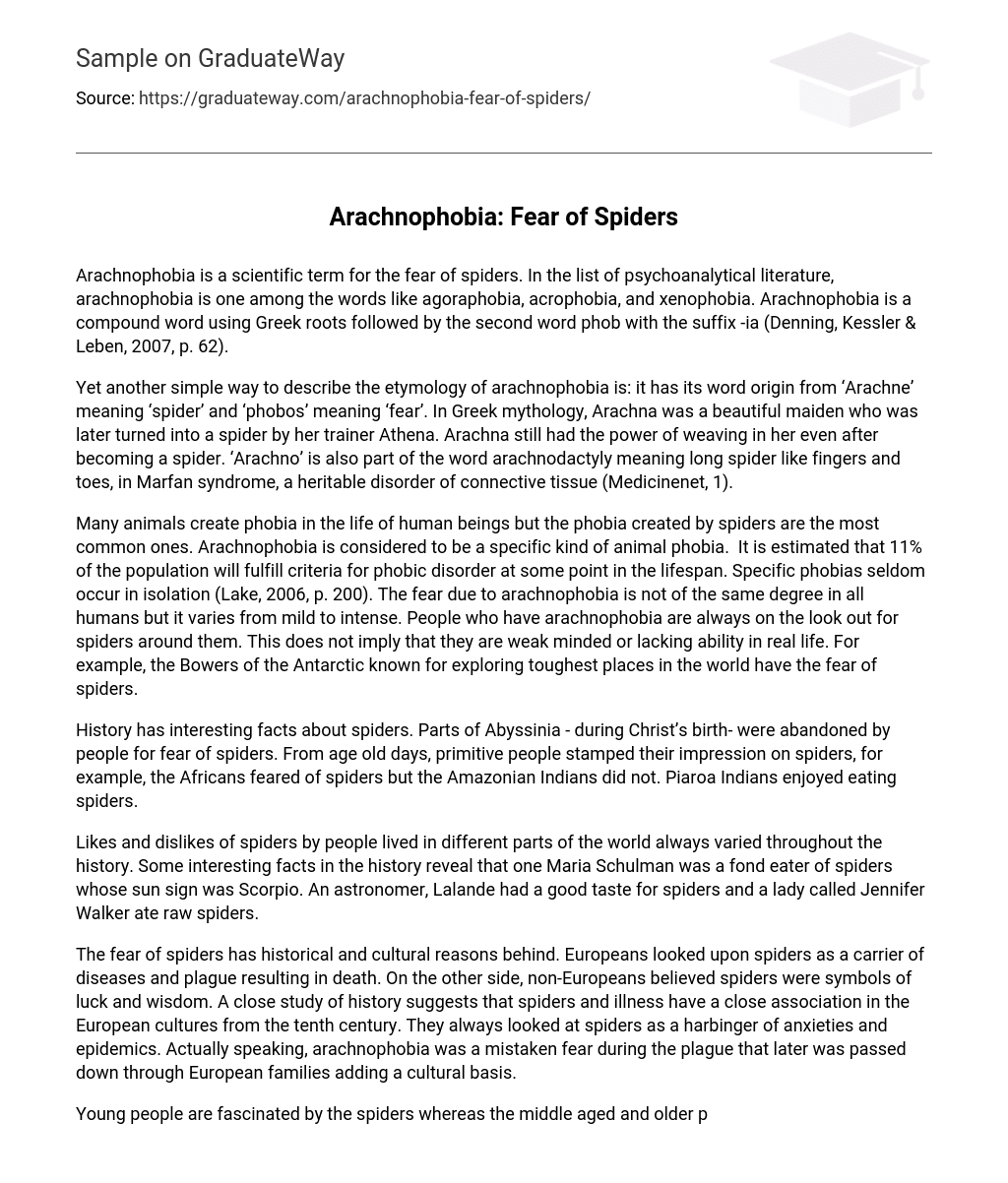Arachnophobia is a scientific term for the fear of spiders. In the list of psychoanalytical literature, arachnophobia is one among the words like agoraphobia, acrophobia, and xenophobia. Arachnophobia is a compound word using Greek roots followed by the second word phob with the suffix -ia (Denning, Kessler & Leben, 2007, p. 62).
Yet another simple way to describe the etymology of arachnophobia is: it has its word origin from ‘Arachne’ meaning ‘spider’ and ‘phobos’ meaning ‘fear’. In Greek mythology, Arachna was a beautiful maiden who was later turned into a spider by her trainer Athena. Arachna still had the power of weaving in her even after becoming a spider. ‘Arachno’ is also part of the word arachnodactyly meaning long spider like fingers and toes, in Marfan syndrome, a heritable disorder of connective tissue (Medicinenet, 1).
Many animals create phobia in the life of human beings but the phobia created by spiders are the most common ones. Arachnophobia is considered to be a specific kind of animal phobia. It is estimated that 11% of the population will fulfill criteria for phobic disorder at some point in the lifespan. Specific phobias seldom occur in isolation (Lake, 2006, p. 200). The fear due to arachnophobia is not of the same degree in all humans but it varies from mild to intense. People who have arachnophobia are always on the look out for spiders around them. This does not imply that they are weak minded or lacking ability in real life. For example, the Bowers of the Antarctic known for exploring toughest places in the world have the fear of spiders.
History has interesting facts about spiders. Parts of Abyssinia – during Christ’s birth- were abandoned by people for fear of spiders. From age old days, primitive people stamped their impression on spiders, for example, the Africans feared of spiders but the Amazonian Indians did not. Piaroa Indians enjoyed eating spiders.
Likes and dislikes of spiders by people lived in different parts of the world always varied throughout the history. Some interesting facts in the history reveal that one Maria Schulman was a fond eater of spiders whose sun sign was Scorpio. An astronomer, Lalande had a good taste for spiders and a lady called Jennifer Walker ate raw spiders.
The fear of spiders has historical and cultural reasons behind. Europeans looked upon spiders as a carrier of diseases and plague resulting in death. On the other side, non-Europeans believed spiders were symbols of luck and wisdom. A close study of history suggests that spiders and illness have a close association in the European cultures from the tenth century. They always looked at spiders as a harbinger of anxieties and epidemics. Actually speaking, arachnophobia was a mistaken fear during the plague that later was passed down through European families adding a cultural basis.
Young people are fascinated by the spiders whereas the middle aged and older people suffer from fear of spiders. Nine out of ten who fear for spiders are found to be women. Sometimes, a picture of spider might trigger the fear. Some of the opinions gathered from children worldwide suggest that spiders are in the forefront of their favorite animal list. About 3% of people develop acute fear of spider and they are apprehended on seeing the creature.
Though scientists have their own explanation about arachnophobia, there is no evidence from where this phobia arises. Arachnophobia can lead to anxiety via sweating and heart palpitations. People with mild fear get away without any treatment whereas acute fear needs a better treatment. Arachnophobes may be having poor knowledge of spiders and so teaching them the real facts or imparting knowledge about spiders in them helps in the treatment of driving the fear away. Modern studies deal with arachnophobia differently. For example, virtual reality simulators are used to treat arachnophobics (Insecta Inspecta World, 1). The patients sit in front of computers where unreal spiders are used to bring down the fear gradually. Psychologists have long observed the wear down effect of the same stimuli repeated over and over in persons suffering from fear of spiders (Bell, 2008, p. 94). In spite of all treatments, doctors insist on moral support (Fear of Spider, 1).
Hollywood produced movies based on the theme of arachnophobia. The first such movie Arachnophobia directed by Frank Marshall was released in the year 1990. The movies entertained people with the real facts shown in magnified proportions by creative artists. Later, there was a video game based on the movie released in the market. This turned out to be a real entertainment for children. Series of books in the form of novels, fiction, and facts were released mainly during the early 90s. Some of the prominent ones are Arachnophobia: A Novel, Arachnophobia: Eight Legs, Two Fangs and an Attitude, Experiential training activities for outside and in, etc. Arachnophobia of course creates serious problems in real life if not to the extent shown in Hollywood movies. Spider bite may cause dermatological lesions that require urgent medical care. Spiders use venom to kill their prey but they hardly remains as a threat to human life. However, one has to be precautious with exceptional spider varieties like Brown Recluse and the Black Widows that are aggressive in nature.
References
Bell, A.A. (2008). Butterflies be gone. USA: McGraw-Hill Professional.
Denning, K.M., Kessler, B., Leben, W.R. (2007). English vocabulary. USA: Oxford University Press.
Fear of Spider. Retrieved June 22, 2009, from http://www.earthlife.net/chelicerata/arachnophobia.html
Insecta Inspecta World. Arachnophobia. Retrieved June 22, 2009, from
http://www.insecta-inspecta.com/culent/arach/
Lake, J. (2006). Textbook of integrative mental health care. New York: Thieme.
Medicinenet. Arachnophobia. Retrieved June 22, 2009, from http://www.medterms.com/script/main/hp.asp





